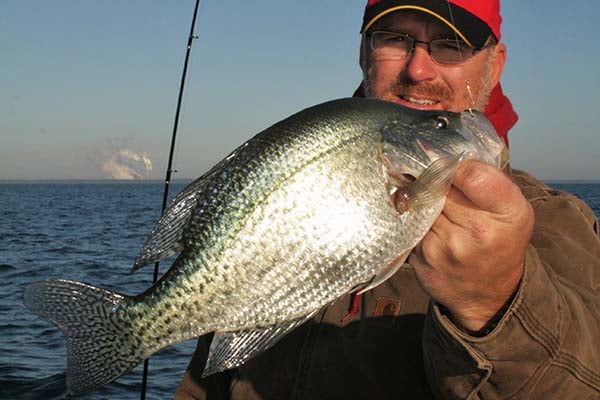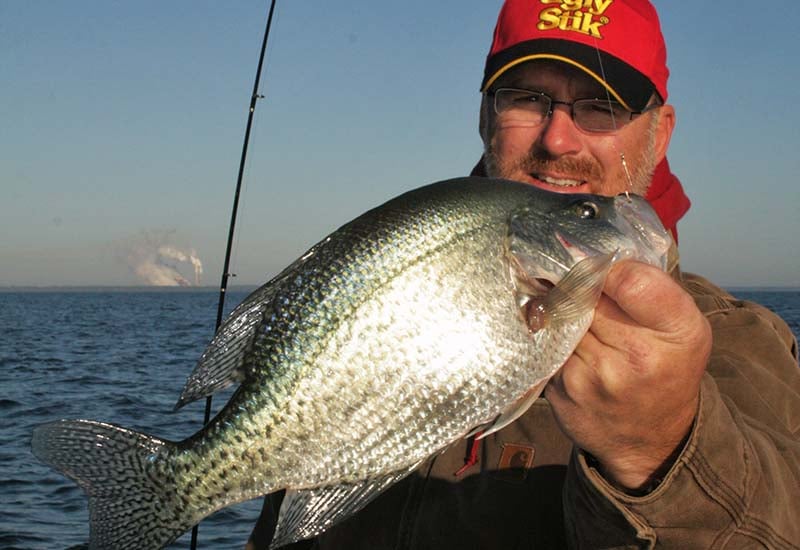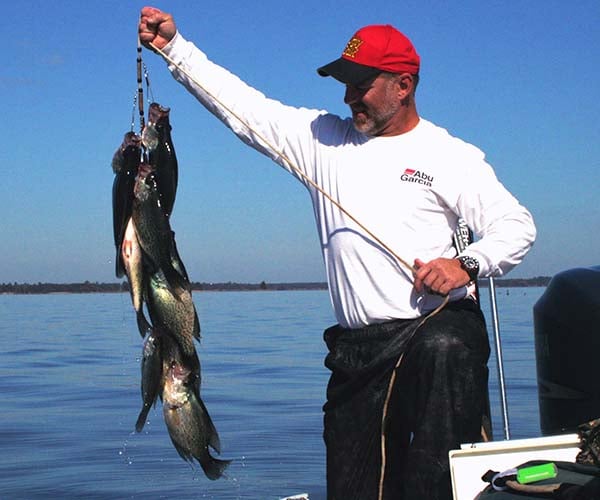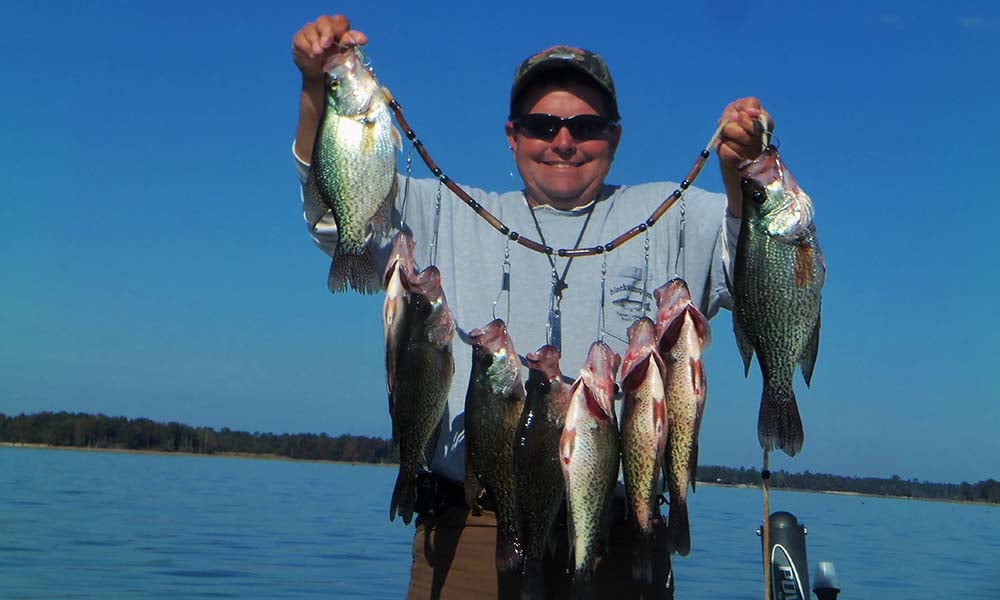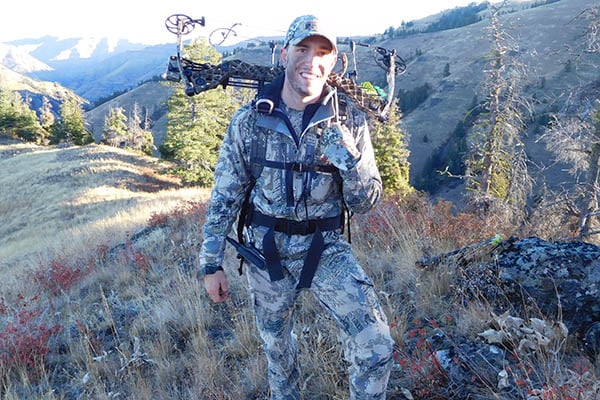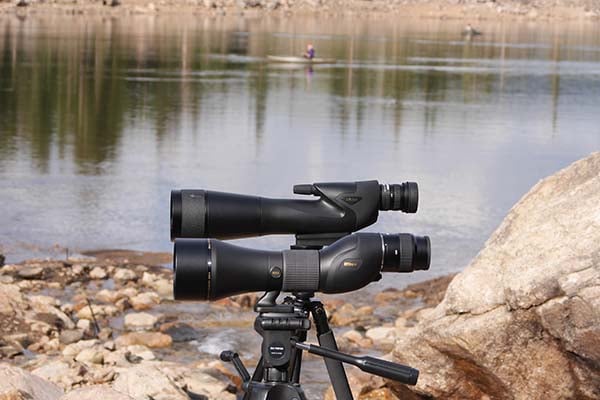Last Updated on
By Pete Rogers
Regardless of what name you call it, Crappie is one of the most popular fish in North America. They are known by a wide array of names such as papermouths, speckled bass, specks, speckled perch, and calico bass. Highly regarded for its table fare, the crappie is arguably one of the best tasting fresh water fish on the continent.
There are two species of crappie that are found in abundance in North America. The black crappie and the white crappie. Both are plentiful, but in some waters the black crappie outnumbers the white crappie. Currently the world record for the black crappie is 5.0 lbs. and 5 lbs. 3 oz for the white crappie.
Crappie are a schooling fish and will also school with other types of pan fish. They prefer underwater structures like fallen trees, weed beds and any other structure that might be submerged. Crappie tend to stay deep under water during daylight hours and only move to shore when feeding, usually at dawn or dusk. During their spring spawning period, they can be found in shallow water in large concentrations.
Fishing Techniques
Fishing for crappie is pretty straight forward making it one of the easier fish to catch year around. Anglers really like the crappie for ice fishing because they do not go into a semi hibernation state. Rather, they stay active during the winter months. In the south, most anglers begin chasing crappie in late February during their pre-spawn period. As the water temperature begins to get into the low 60s, crappie begin moving into shallow water and staging before spawning. Very large numbers of fish are found in these schools. Anglers can easily catch their limit of fish in one location during the spring spawn.
Methods of catching crappie include trolling jigs and minnows in the mouths of creeks, submerged humps, and brushpiles in water up to twenty feet. Also areas along the shore where deep water is present is good to locate staging fish. As the water warms, the fish move shallower until the spawn and then return to deeper water.
Brad Taylor of Lake Murray in South Carolina likes to locate fish with his electronics and position directly over them and drop minnows down to the fish. “It is hard to fish a minnow wrong.” Taylor says. He prefers live bait over the artificial lures: “Crappie can be so selective with artificial bait, but the minnow – is a minnow, and if they are there, they will eat the minnow.” Taylor is not alone in this belief and tactic. Many anglers prefer the simplicity and confidence a minnow will give them. Used on a 1/4 oz jig head, the minnow is hooked either through the lips or through the middle of the body and allows to swim and wiggle around.
“I find the fish at a certain depth, and make sure I set my minnow directly on top of that depth.” Taylor says. For example, if the fish are suspended at twelve feet, Taylor places his minnow at eleven feet to catch the attention of the crappie. “I believe the fish almost always feed up.” Taylor says. “So placing my bait above the crappie allows them to see the bait better and strike it better.
Common tackle for crappie is widely scattered among anglers. Perhaps most common are the very long flexible poles with small reels. Rods out to twelve feet in length are common with those in the seven to ten feel being the most common. “I like a rod about seven to eight feet with a lot of action on it.” Taylor says. He preferrs poles a tad shorter than many others. This gives the angler the opportunity to set the hook and to enjoy the brief fight.
Those using artificial bait are mostly using jigs in the 1/8 to ¼ oz. size tipped with some type of soft plastic. The variety of soft plastic baits available for crappie fishing are legion. Every color under the rainbow, and then some, are available. From straight grubs, to curly tails, split tails to tubes, you name it and it’s available.
The most common among anglers is the straight grub in white. Kevin Davis, Owner of Blacks Camp at the world famous Santee Cooper Lakes in South Carolina has been guiding for crappie and other fish for over thirty years. He knows how to catch crappie and a lot of them. Davis uses minnows but prefers artificial bait to catching big crappie. He believes that by concentrating crappie and placing the right bait there, you can catch bigger and better crappie.
“I have over three hundred brush piles in these lakes.” Davis says. “Everyone knows crappie love brush piles, so I put brush piles out to concentrate the crappie.” Davis is understandably secretive about just how and where he places his brush piles but did offer this advice: “Christmas trees are very good for brush piles. Too many anglers only use one or two trees. If you want the brush pile to be there for a while, you need ten or more in one location. You have to have enough brush to hide a lot of crappie.” Some of Davis’ piles have fifty or more trees to make a big brush pile scattered over a small region. Davis says that he likes to check his brush piles and find active fish. He uses a variety of lure colors, and he drops jigs, tube bait, grubs and others into the brush pile. When he catches two fish on the same lure, he changes everything over to that color and type. “Crappie are finicky, when they like red lures, you won’t catch them on white. If they want white, you won’t catch them on green. You never know from one day to the next what the color of the day will be. So try a lot of different colors.”
Anglers who love crappie have often stocked their local farm pond with this fish in hopes of having plenty of fish to catch and eat. Being such prolific breeders, the crappie very quickly will over run small bodies of water like farm ponds and overpopulate the pond making it difficult for other fish to thrive. One biologist recommends not stocking your pond with crappie. They will find their way in there on their own. But if you do decide to stock your pond with crappie, you have to keep it in check. Controlling the population can seem wasteful, but catching and keeping thousands of fish a year is not uncommon for smaller ponds.
Some die hard anglers target crappie only at night. They are commonly more aggressive at night. Some of the best tactics include using a floating light to concentrate bait fish, and fishing directly under the light. Bridges, docks and brush piles are common targeted areas for night time anglers. Recently the use of submerged lights have proven to be effective. Anglers drop a light down five to ten feet and put the bait fish on the light, and the crappie often find the bait easier to find.
The crappie will remain one of the most popular fish in North America. Its abundance and table fare along with relative ease of catching make it the perfect species to introduce kids to fishing. Kids need a lot of action to stay interested. Setting them over a brush pile loaded with slabs of crappie can and does make life long anglers of many of us. Found all over the country, crappie are a great game fish for anglers of all ages and skill levels.
